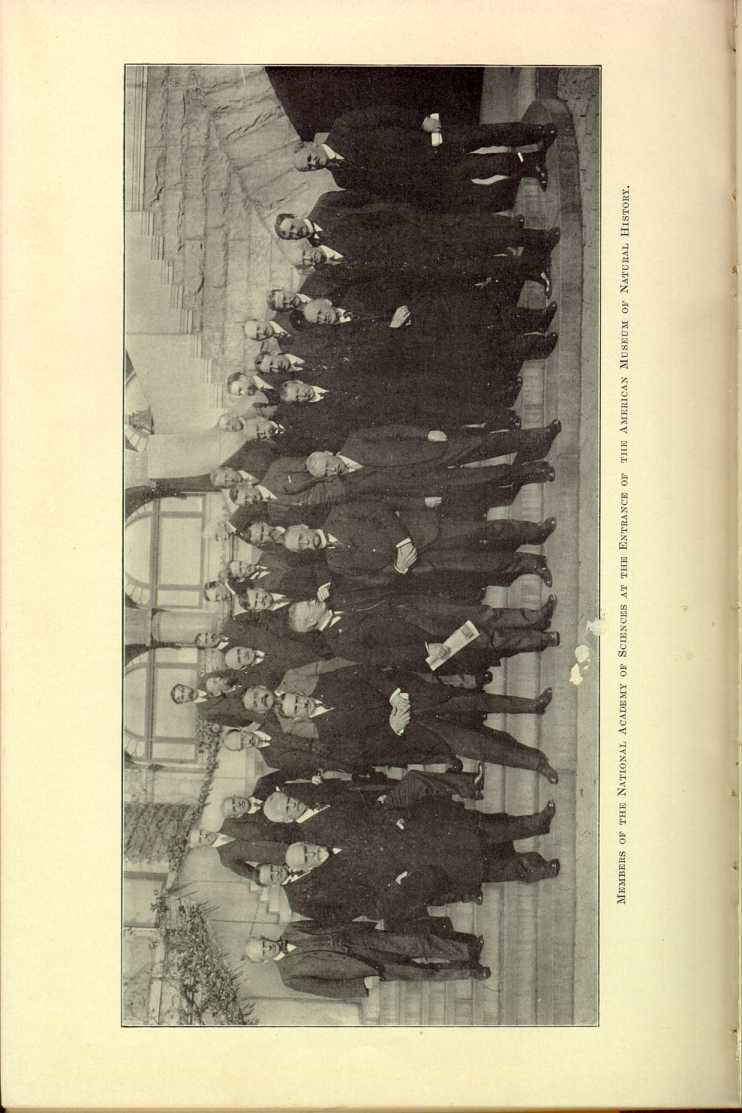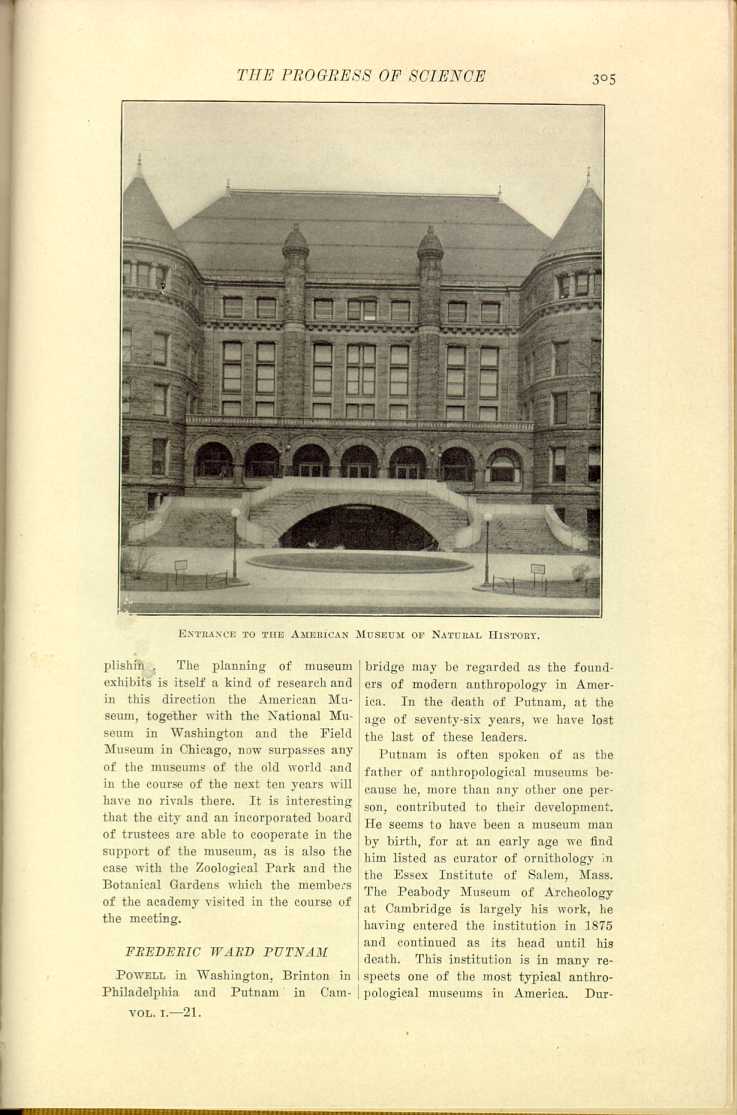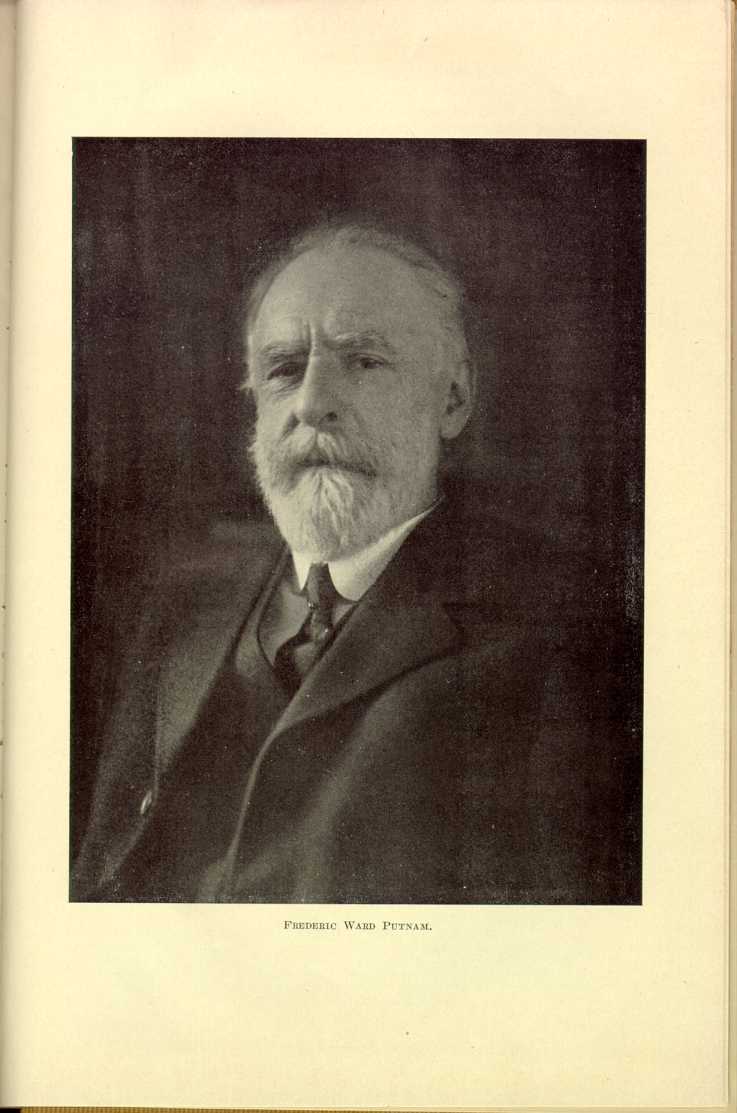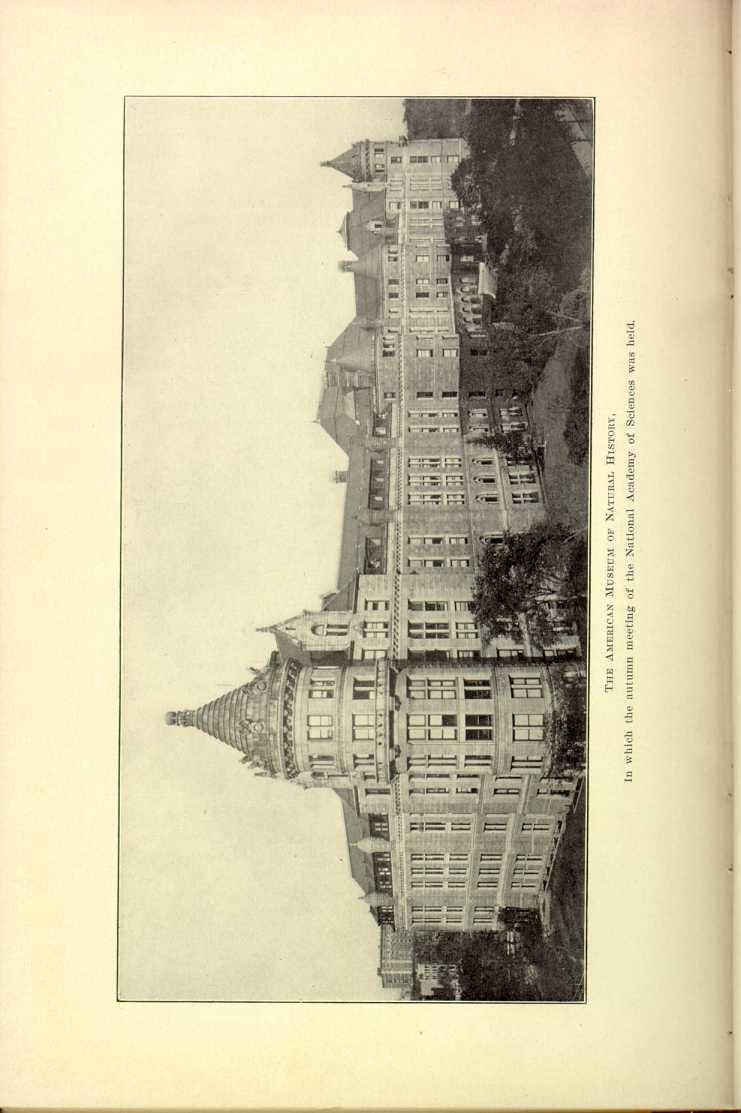| The Scientific Monthly | ||
THE PROGRESS OF SCIENCE
THE NEW YORK MEETING OF
THE NATIONAL ACADEMY
OF SCIENCES
THE National Academy of Sciences held its annual autumn meeting during the third week of November in the American Museum of Natural History. The central situation of New York City and its scientific attractions led to a large meeting and an excellent program There were present over sixty members, nearly one half of a membership widely scattered over the country. When the academy was established in 1863 as the adviser of the government in scientific questions, the membership was limited to fifty which was subsequently increased to 100, under which it was kept until recently. The present distribution of the 141 members among different institutions in which there are more than two is: Harvard, 19; Yale, 15; Chicago, 13; Johns Hopkins, 12; Columbia, 11; U. S. Geological Survey, 8; Carnegie Institution, 5; California, Rockefeller Institute, Smithsonian, 4; Clark, Wisconsin, Cornell, Stanford, 3.
The scientific program of the meeting began with a lecture by Professor Michael I. Pupin, of Columbia University, who described the work on aerial transmission of speech of which no authentic account has hitherto been made public. To Professor Pupin we owe the discovery through mathematical analysis and experimental work of the telephone relays which recently made speech by wire between New York City and San Francisco possible, and we now have an authoritative account of speaking across the land and sea a quarter way round the earth. One session of the academy was devoted to four papers of general interest. Professor Herbert S. Jennings, of the Johns Hopkins University, described experiments showing evolution in progress, and Professor John M. Coulter, of the University of Chicago, discussed the causes of evolution in plants Professor B. B. Boltwood made a report on the life of radium which may he regarded as a study of inorganic evolution. Professor Theodore Richards, of Harvard University, spoke of the investigations recently conducted in the Wolcott Gibbs Memorial Laboratory. These are in continuation of the work accomplished by Professor Richards in the determination of atomic weights, which led to the award to him of a Nobel prize, the third to be given for scientific work done in this country, the two previous awards having been to Professor Michelson, of the University of Chicago, in physics, and Dr. Carrel, of the Rockefeller Institute, in physiology.
Of more special papers, some of which, however, were of general and even popular interest, there were on the program 36, distributed somewhat unequally among the sections into which the academy is divided as follows: Mathematics, 0; Astronomy, 3; Physics and Engineering, 7; Chemistry, 1; Geology and Paleontology, 6; Botany, 7; Zoology and Animal Morphology, 8; Physiology and Pathology, 4; Anthropology and Psychology, 0. A program covering all the sciences belongs in a sense to the eighteenth rather than to the twentieth century; still there is human as well as scientific interest in listening to those who are leaders in the conduct of scientific work.
The academy was fortunate in meeting in the American Museum of Natural History, where in addition to the scientific sessions luncheon and an evening reception were provided. The museum has assumed leadership both in exhibits for the public and in the scientific research which it is accomplishing.

MEMBERS OF THE NATIONAL ACADEMY OF SCIENCES AT THE ENTRANCE OF THE AMERICAN MUSEUM OF NATURAL HISTORY.
[Description: Group photograph of the members of the National Academy of Sciences, taken in front of the American Museum of Natural History.]
ENTRANCE OF THE AMERICAN MUSEUM OF NATURAL HISTORY.
[Description: Photograph of the entrance to the American Museum of Natural History.]FREDERIC WARD PUTNAM
POWELL in Washington, Brinton in Philadelphia and Putnam in Cambridge may be regarded as the founders of modern anthropology in America. In the death of Putnam, at the age of seventy-six years, we have lost the last of these leaders.
Putnam is often spoken of as the father of anthropological museums because he, more than any other one person, contributed to their development. He seems to have been a museum man by birth, for at an early age we find him listed as curator of ornithology in the Essex Institute of Salem, Mass. The Peabody Museum of Archeology at Cambridge is largely his work, he having entered the institution in 1875 and continued as its head until his death. This institution is in many respects one of the most typical anthropological museums in America. During
The one new and important idea which Professor Putnam brought into his museum work was that they should be in reality institutions of research. Until that time they were chiefly collections of curios brought together by purchase of miscellaneous collections without regard to the scientific problems involved. Professor Putnam's idea was that the museum should go into the field and by systematic research and investigation develop a definite problem, bringing to the museum such illustrative and concrete data as should come to hand in the prosecution of research. Professor Putnam also played a large part in securing the recognition of anthropology by universities and by his position at Harvard pointed the way to mutual cooperation between museums and universities. He possessed an unusual personality which enabled him to approach and interest men of affairs so as to secure their financial support for anthropological research and as a teacher he was intensely interested in young men, offering them every possible opportunity for advancement and never really losing personal interest in them as long as he lived.
SCIENTIFIC ITEMS
WE record with regret the deaths of Brigadier-general George M. Sternberg, retired, surgeon-general of the army, from 1893 to 1902, distinguished for his investigations of yellow fever and other diseases; of Edward Lee Greene, associate in botany at the Smithsonian Institution; of Wirt Tassin, formerly chief chemist and assistant curator of the division of mineralogy, U. S. National Museum; of Augustus Jay Du Bois, for thirty years professor of civil engineering in the Sheffield Scientific School, Yale University; of Sir Andrew Noble, F.R.S., distinguished for his scientific work on artillery and explosives; of Edward A. Minchin, F.R.S., professor of protozoology in the University of London, and of R. Assheton, F.R.S., university lecturer in animal embryology at the University of Cambridge.
THE Nobel prize for chemistry for 1914 has been awarded to Professor Theodore William Richards, of Harvard University, for his work on atomic weights. The prize for physics has been awarded to Professor Max

FREDERIC WARD PUTNAM.
[Description: Photograph of a bearded man (Frederic Ward Putnam) in a dark three-piece suit.]PROFESSOR ADOLF VON BAEYER celebrated his eightieth birthday on October 31. With the beginning of the present semester he retired from the chair of chemistry at Munich in which he succeeded von Liebig in 1875.—The Romanes lecture before the University of Oxford will be delivered this year by Professor E. B. Poulton, Hope professor of zoology in the university, on December 7. The subject will be "Science and the Great War.''
AT the recent meeting in Manchester, as we learn from Nature, the general committee of the British Association unanimously adopted the following resolution, which has been forwarded to the Prime Minister, the Chancellor of the Exchequer and the Presidents of the Board of Education and of Agriculture and Fisheries: "That the British Association for the Advancement of Science, believing that the higher education of the nation is of supreme importance in the present crisis of our history, trusts that his Majesty's government will, by continuing its financial support, maintain the efficiency of teaching and research in the universities and university colleges of the United Kingdom.''
COLUMBIA UNIVERSITY received by the will of Amos F. Eno the residuary estate which may amount to several million dollars. In addition, the General Society of Mechanics and Tradesmen receives $1,800,000, and bequests of $250,000 each are made to New York University, The American Museum of Natural History, the Metropolitan Museum of Art and the New York Association for improving the Condition of the Poor—Mr. James J. Hill has presented $125,000 to Harvard University to be added to the principal of the professorship in the Harvard graduate school of business administration, which bears his name. The James J. Hill professorship of transportation was founded by a gift of $125,000, announced last commencement day, the donors including John Pierpont Morgan, Thomas W. Lamont, Robert Bacon and Howard Elliott.— The sum of about $400,000 has been subscribed in the University of Michigan alumni campaign for $1,000,000 with which to build and endow a home for the Michigan Union, as a memorial to Dr. James B. Angell, president emeritus.
| The Scientific Monthly | ||
